A Method for Measuring Spatial Information of Area Maps Considering the Diversity of Node–Edge and Gestalt Principles
Abstract
:1. Introduction
2. Related Work
2.1. Geometric Information Content Measurement of Area Objects
2.2. Spatial Distribution Information Content Measurement of Area Map
2.3. Existing Shortcomings
- (1)
- The existing methods for measuring the geometric information content of area objects lack a unified calculation standard and rely heavily on manual experience, resulting in high degrees of error and subjectivity in the calculation results.
- (2)
- The existing methods for measuring spatial distribution information content only consider the richness of spatial adjacency and spatial occupancy information, while failing to effectively consider the spatial morphological relationships, spatial distance relationships, and further spatial arrangement characteristics of area objects.
- (3)
- There is currently no theoretically feasible solution for comprehensively measuring the geometric information and spatial distribution information of area maps. The current approach of combining weights based on manual experience carries an uncertain degree of subjectivity.
3. Method
3.1. The Overall Framework of the Proposed Method
3.2. Diversity of Node
3.3. Diversity of Edge
3.4. Information Decay Based on Gestalt Cognitive Principles
3.5. Calculation of Spatial Information Content in Area Maps
4. Results
4.1. Experimental Design and Comparative Methods
4.1.1. Experimental Design
4.1.2. Experimental Parameters
4.1.3. Comparative Methods
4.2. Experiment 1: Consistency Analysis of Spatial Information Content and the Degree of Disorderly Arrangement of Area objects
4.3. Experiment 2: Consistency Analysis of the Simplification Level of Area Maps and Spatial Information Content
5. Discussion
- (1)
- The spatial information content in a map is only related to the scale of the spatial distribution structure and is not limited by the map extent;
- (2)
- There is no need to balance the Voronoi diagram area of objects in the margin of the map by manually extending the map extent, thus reducing the uncertainty of measurement results.
5.1. The Comparability of Eigenvalues
5.2. The Consideration of the Diversity of Spatial Distances and Adjacency Relationships
5.3. The Measurement of Information with Regular Distribution and Arrangement
5.4. The Coupling of Geometric Information and Spatial Distribution Information
6. Conclusions
Author Contributions
Funding
Institutional Review Board Statement
Informed Consent Statement
Data Availability Statement
Conflicts of Interest
References
- Ke, L. Retrospect and Prospect of the Development of Chinese Cartography. Acta Geod. Cartogr. Sin. 2017, 46, 1517–1525. [Google Scholar] [CrossRef]
- Li, Z.; Gao, P.; Zhu, X. Information Theory of Cartography: An Information-theoretic Framework for Cartographic Communication. J. Geod. Geoinf. Sci. 2021, 4, 1–16. [Google Scholar] [CrossRef]
- Bjørke, J.T. Exploration of Information Theoretic Arguments for the Limited Amount of Information in a Map. Cartogr. Geogr. Inf. Sci. 2012, 39, 88–97. [Google Scholar] [CrossRef]
- Li, Z.; Liu, Q.; Gao, P. Entropy-based Cartographic Communication Models: Evolution from Special to General Cartographic Information Theory. Acta Geod. Cartogr. Sin. 2016, 45, 757–767. [Google Scholar] [CrossRef]
- Wang, H. Research on Quantity Measurement of Basic Geographic Information in Topographic Database. Liaoning Technical University. 2010. Available online: https://kns.cnki.net/kcms2/article/abstract?v=fsvnL9wA1q0Z03MJjIch-ioV7_lOxyrpPOD3OZxM_u0nBOSnK6rzNgojj1AyLnrDotaycFDEUjpW7GqYyb-h_FkklYDonZO10dbhg2zeBGNzxVzRIp3wTAgpeALC1ccGKSKBPsQbsmDX45-Mp_q05w==&uniplatform=NZKPT&language=CHS (accessed on 15 July 2011).
- Li, A.; Chen, Y.; Yao, M.; Wu, S. Quantitative Measurement of Geometrical Information for Sensitive Features in Secret-related Vector Digital Maps. J. Geo-Inf. Sci. 2018, 10, 7–16. [Google Scholar]
- Harrie, L.; Stigmar, H. An evaluation of measures for quantifying map information. ISPRS J. Photogramm. Remote Sens. 2010, 65, 266–274. [Google Scholar] [CrossRef]
- Wang, S.; Wang, Z.; Du, Q. A measurement method of geometrical information considering multi-level map feature. Sci. Surv. Mapp. 2007, 32, 60–62+194. [Google Scholar]
- Zhao, W.; Fei, L. Syntax-based information quantity rule for automatic map generalization. Sci. Surv. Mapp. 2007, 32, 21–23+204. Available online: https://chkd.cbpt.cnki.net/WKE2/WebPublication/paperDigest.aspx?paperID=5beaa2ac-52ca-4974-88ce-d601cded099a (accessed on 20 November 2007).
- Liu, H.; Deng, M.; He, Z.; Xu, Z. An Approach to Measuring the Spatial Information Content of an Area Feature. J. Geo-Inf. Sci. 2012, 14, 744–750. [Google Scholar] [CrossRef]
- Harrie, L.; Stigmar, H.; Djordjevic, M. Analytical Estimation of Map Readability. Int. J. Geo-Inf. 2015, 4, 418–446. [Google Scholar] [CrossRef]
- Dai, L.; Zhang, K.; Zheng, X.S.; Martin, R.R.; Li, Y.; Yu, J. Visual complexity of shapes: A hierarchical perceptual learning model. Vis. Comput. 2022, 38, 419–432. [Google Scholar] [CrossRef]
- Basaraner, M.; Cetinkaya, S. Performance of shape indices and classification schemes for characterising perceptual shape complexity of building footprints in GIS. Int. J. Geogr. Inf. Sci. 2017, 31, 1952–1977. [Google Scholar] [CrossRef]
- Liu, Y.; Li, W. A New Algorithms of Stroke Generation Considering Geometric and Structural Properties of Road Network. ISPRS Int. J. Geo-Inf. 2019, 8, 304. [Google Scholar] [CrossRef]
- He, J.; Zhang, H.; Cao, W.; Lan, T. A new approach for quantifying the topological information considering the compact and heterogeneous structure of map symbols. Sci. Surv. Mapp. 2017, 42, 131–135. Available online: https://chkd.cbpt.cnki.net/WKE2/WebPublication/paperDigest.aspx?paperID=659219f9-2b0a-4000-9d04-0e7334c58d63 (accessed on 20 January 2017).
- Li, Z.; Huang, P. Quantitative Measures for Spatial Information of Maps. Int. J. Geogr. Inf. Sci. 2002, 16, 699–709. [Google Scholar] [CrossRef]
- Liu, H.; Deng, M.; Fan, Z.; Lu, Q. A Characteristics-based Approach to Measuring Spatial Information Content of the Settlements in a Map. Acta Geod. Cartogr. Sin. 2014, 43, 1092–1098. [Google Scholar] [CrossRef]
- Liu, P.; Xiao, T.; Xiao, J.; Ai, T. A multi-scale representation model of polyline based on head/tail breaks. Int. J. Geogr. Inf. Sci. 2020, 34, 2275–2295. [Google Scholar] [CrossRef]
- Susan, S.; Kenan, B.; Arzu, Ç. Measured and perceived visual complexity: A comparative study among three online map providers. Cartogr. Geogr. Inf. Sci. 2018, 45, 238–254. [Google Scholar] [CrossRef]
- Ai, T.; He, Y.; Du, X. Information Entropy Change in GIS Data Scale Transformation. Geogr. Geo-Inf. Sci. 2015, 31, 7–11. Available online: https://kns.cnki.net/kcms2/article/abstract?v=ttOPOQ75YvLaIvJ-6A6WV2dFIC2LLKmBjujBGXQF_EE5d1f8p4GByjlWfhLd9wf5cpCbcDsHAtch_IHh-FojcvGinDWLEzrSiqOYil8Q17YYykKQaEQkNLEqWSQN46LcHBqbJnZEE7gVy_A-KbAYUA==&uniplatform=NZKPT&language=CHS (accessed on 15 March 2015).
- Cheng, M.; Sun, Q.; Xu, L.; Chen, H. Polygon contour similarity and complexity measurement and application in simplification. Acta Geod. Cartogr. Sin. 2019, 48, 489–501. [Google Scholar] [CrossRef]
- Parent, J.; Civco, D.; Angel, S. Shape metrics (presentation). In ESRI 2009 User Conference; University of Connecticut: Storrs, CT, USA, 2009. [Google Scholar]
- Chen, Y.; Sundaram, H. Estimating Complexity of 2D Shapes. In Proceedings of the 2005 IEEE 7th Workshop on Multimedia Signal Processing, Shanghai, China, 30 October–2 November 2005; Available online: https://ieeexplore.ieee.org/document/4014089 (accessed on 20 November 2006).
- Su, H.; Bouridane, A.; Crookes, D. Scale Adaptive Complexity Measure of 2D Shapes. In Proceedings of the 18th International Conference on Pattern Recognition, Hong Kong, China, 20–24 August 2006; Available online: https://ieeexplore.ieee.org/document/1699165 (accessed on 18 September 2006).
- Dai, L.; Zhang, J.; Peng, R.; Wang, J.; Yu, J. Computational Evaluation of Logo Shape Complexities. J. Comput.-Aided Des. Comput. Graph. 2017, 29, 1786–1793. Available online: https://www.jcad.cn/cn/article/id/b7917c7f-94d3-44a9-9da4-313a1ae6151d (accessed on 15 October 2017).
- Neumann, J. The Topological Information Content of a Map/An Attempt at A Rehabilitation of Information Theory in Cartography. Cartographica 1994, 31, 26–33. Available online: https://kns.cnki.net/kcms2/article/abstract?v=ttOPOQ75YvLS6vqGip2cdHv-kxFdXe0KA2NTtBxZVtv4Q97OXV6zTN2byiWl8uGK_OA66LM6sCtCwm-VpyLZGyOo8pqh2yYgO_L_lEFFDRwWji3JmIcCi6RP0_hS8-dKxeTbi3UxVfg=&uniplatform=NZKPT&language=CHS (accessed on 30 March 1997). [CrossRef]
- Kang, Q.; Zhou, X.; Hou, D.; Nawaz, A.; Luo, S.; Zhao, S. A method for measuring geometric information content of area cartographic objects based on discrepancy degree of shape points. Geocarto Int. 2023, 38, 2275685. [Google Scholar] [CrossRef]
- Ai, T.; Guo, R. Polygon Cluster Pattern Mining Based on Gestalt Principles. Acta Geod. Cartogr. Sin. 2007, 3, 302–308. Available online: https://kns.cnki.net/kcms2/article/abstract?v=ttOPOQ75YvJ9OA9x7aPm81hcO5GiJfgmnsI7DDKYSny_Klf-9lyx2SyIEXNZYj9JveXT4xS3ShUc_8rlCLqdFxL_ARYPI-Wt2rzTK7qqWnxT3lT33DwOsfYRb2TfqqhPQQA_jO-mz6o=&uniplatform=NZKPT&language=CHS (accessed on 15 August 2007).
- Koffka, K. Principles of Gestalt Psychology; Harcourt. Brace: New York, NY, USA, 1935. [Google Scholar]
- Graham, L. Gestalt theory in interactive media design. J. Humanit. Soc. Sci. 2008, 2, 571. Available online: https://www.mendeley.com/catalogue/a9fa13bc-41ba-3604-89c2-062cfb003c90/ (accessed on 30 June 2008).
- Palmer, S.E. Common region: A new principle of perceptual grouping. Cogn. Psychol. 1992, 24, 436–447. [Google Scholar] [CrossRef]
- ROCK. Indirect Perception; MIT Press: London, UK, 1996. [Google Scholar]
- Li, Z.; Yan, H.; Ai, T.; Chen, J. Automated building generalization based on urban morphology and Gestalt theory. Int. J. Geogr. Inf. Sci. 2004, 18, 513–534. [Google Scholar] [CrossRef]
- Attneave, F. Some informational aspects of visual perception. Psychol. Rev. 1954, 61, 183–193. [Google Scholar] [CrossRef] [PubMed]
- Patricios, N.N. Urban design principles of the original neighbourhood concepts. Urban Morphol. 2002, 6, 21–32. [Google Scholar] [CrossRef]
- Ou, W.; Yao, X. Measurement of map information content-the general eigenvalue measuring method. Map 1988, 4, 3–7. Available online: https://kns.cnki.net/kcms2/article/abstract?v=ttOPOQ75YvIT1iD0tUMbDfzeRe6c5bJF_NkfK61K2EwMX3C_C7ySRCTHYXip45f0FlHPoKX7M79f4yCBhnpe6zY9IVe8s-V6RrKhCcccUCMezh5fCayVinJ5XAYJ2-finftnyO-QKPw=&uniplatform=NZKPT&language=CHS (accessed on 30 December 1988).
- Liu, P.; Li, X.; Liu, W.; Ai, T. Fourier-based multi-scale representation and progressive transmission of cartographic curves on the internet. Cartogr. Geogr. Inf. Sci. 2016, 43, 454–468. [Google Scholar] [CrossRef]
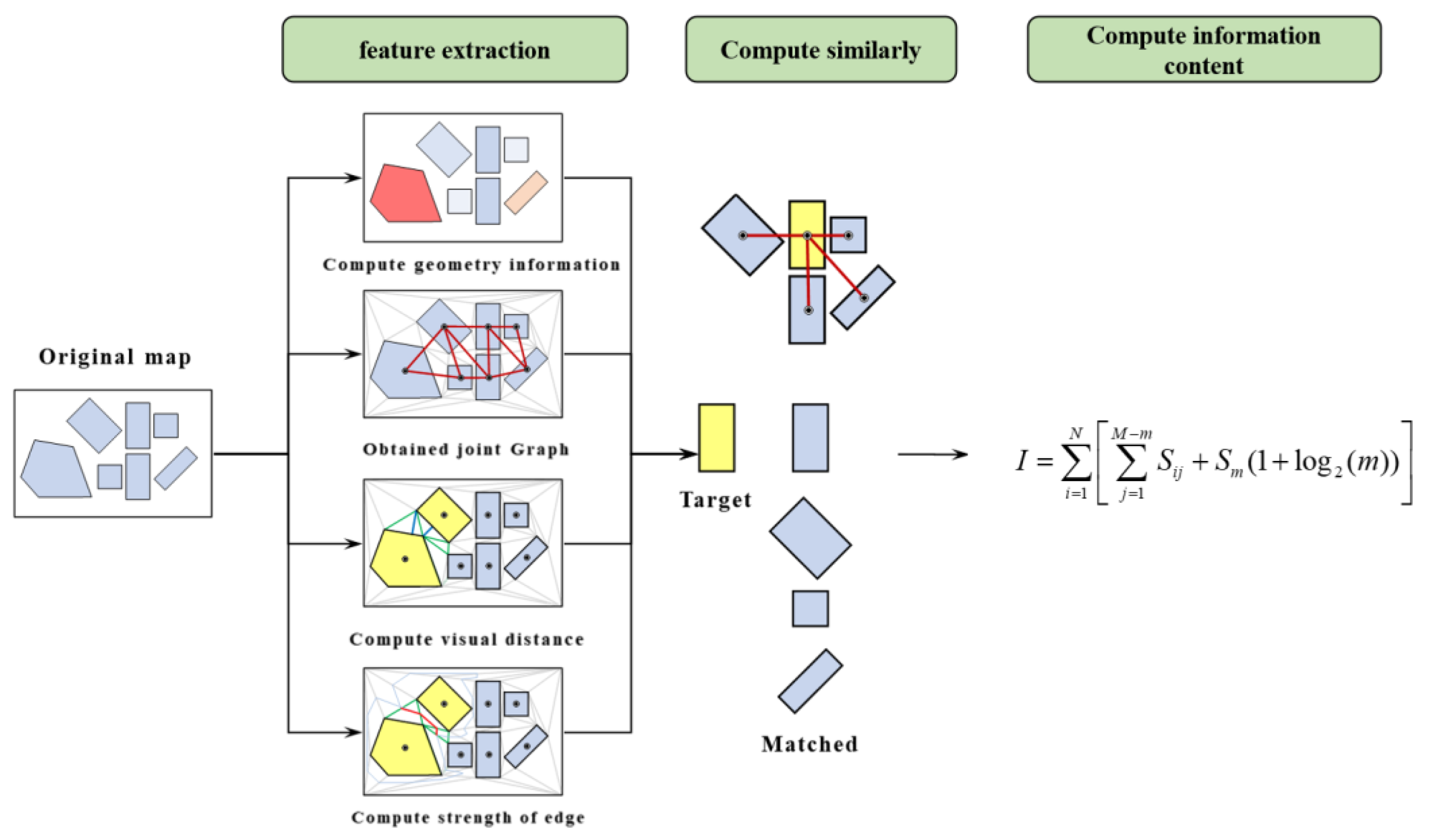

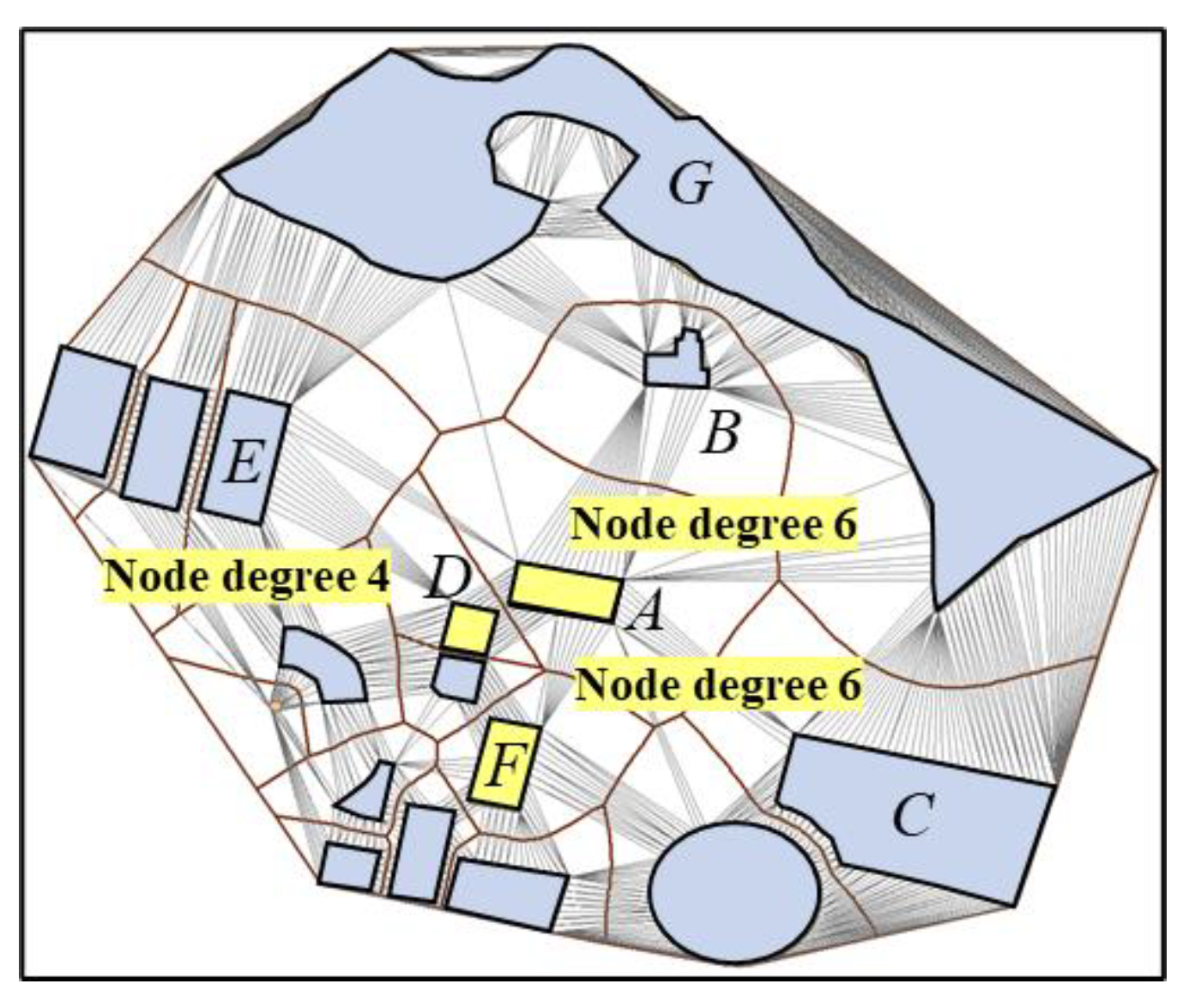
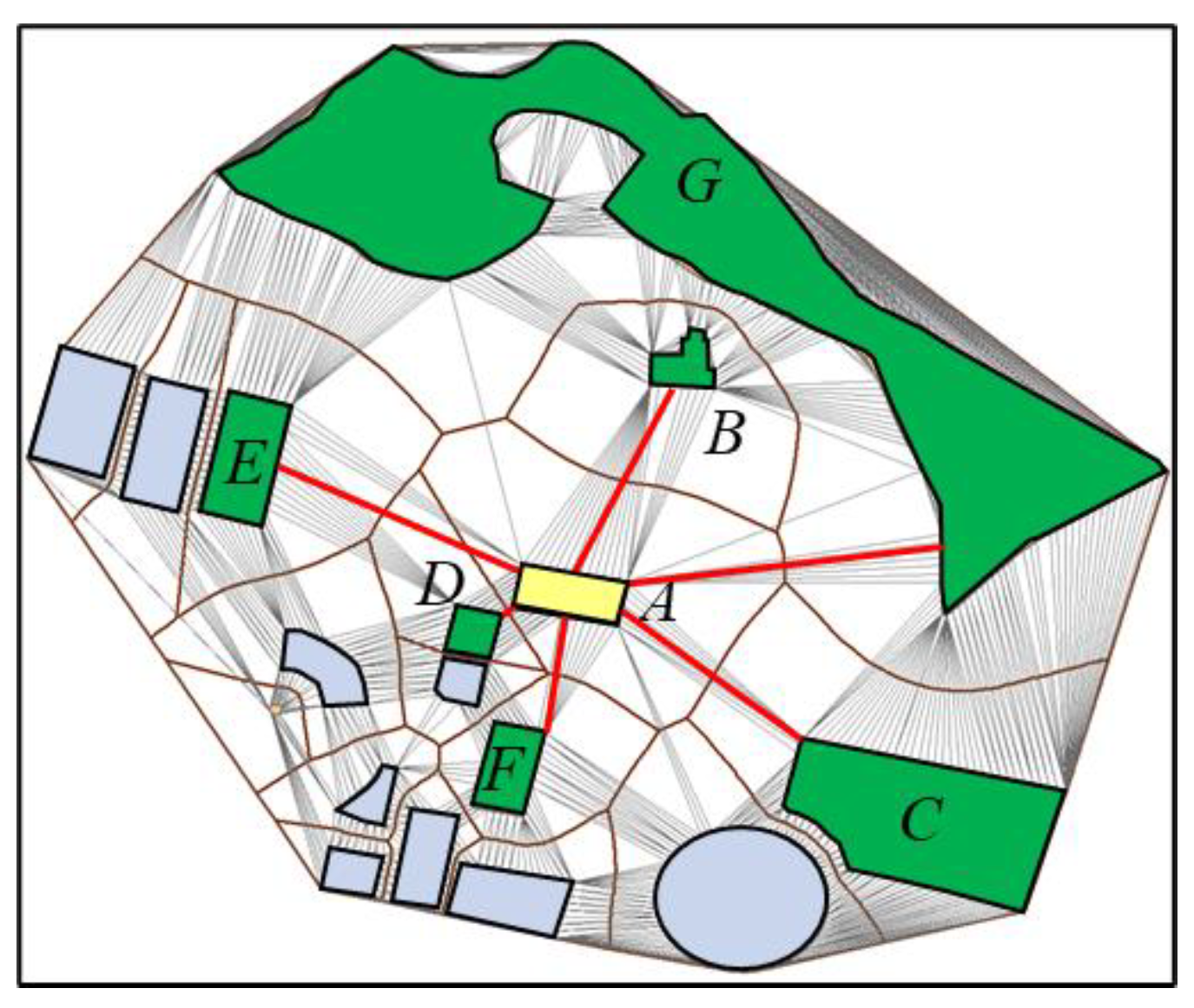


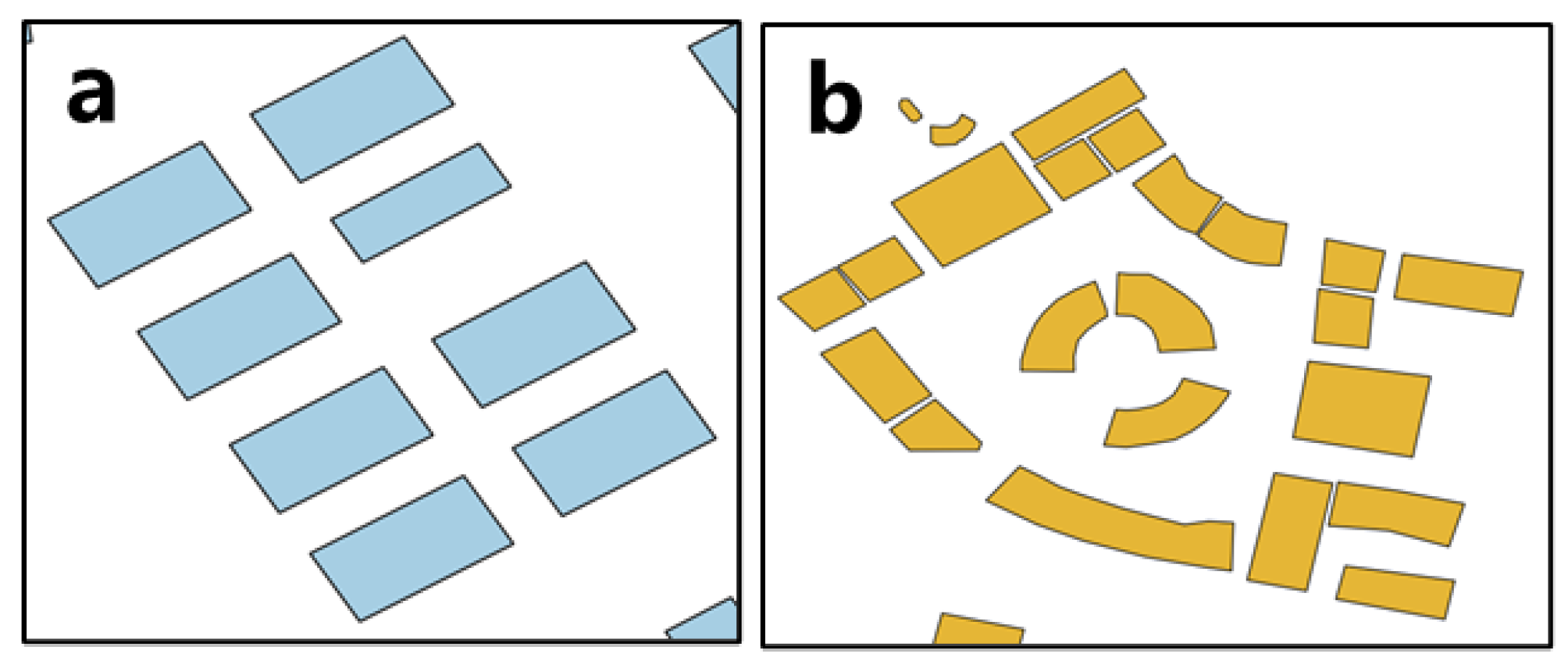

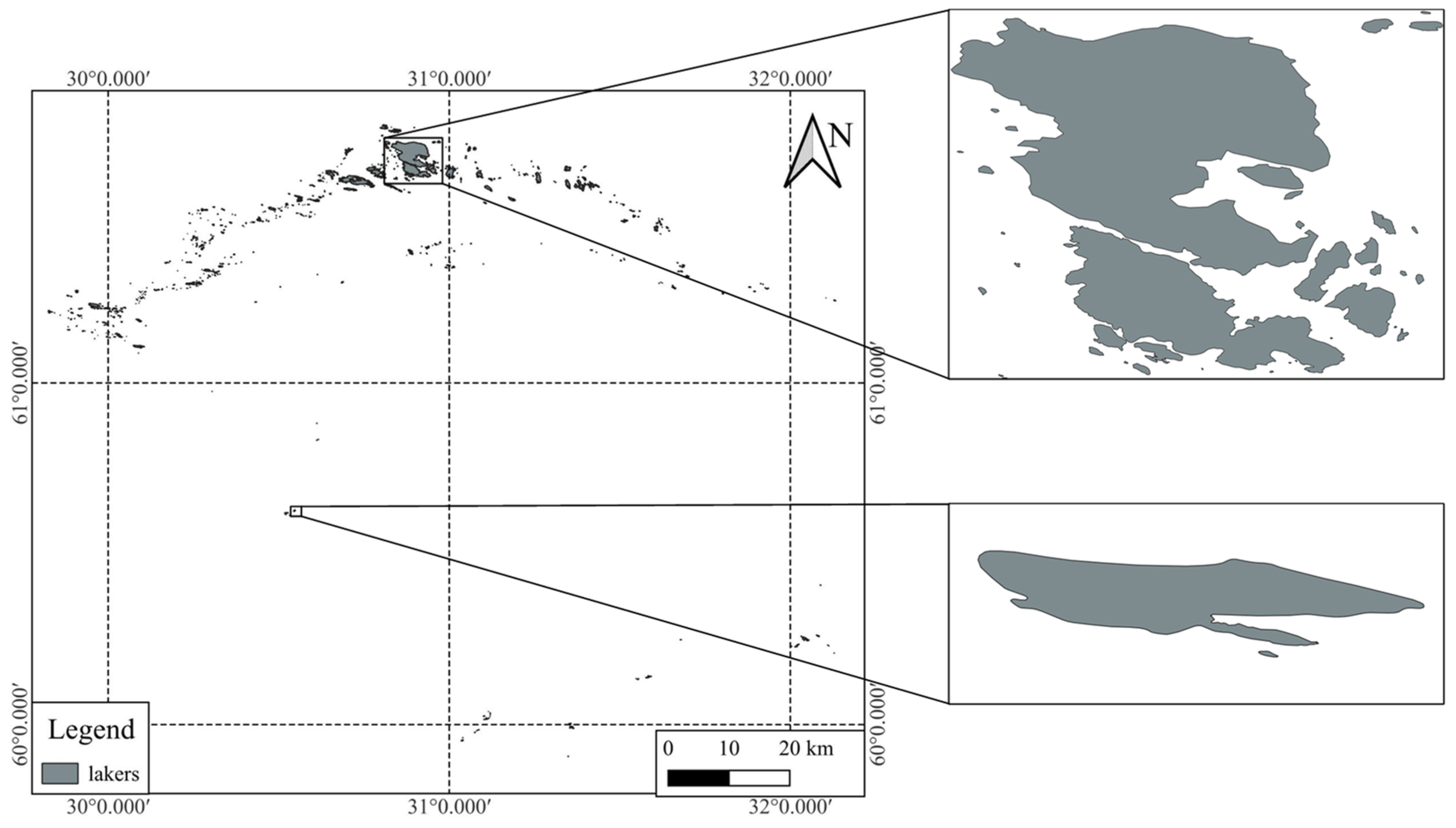

| Method | Calculation Formula | Description |
|---|---|---|
| Li’s methods for spatial distribution information | “Nconnect” represents the node degree; M represents the total number of connecting edges in a map. | |
| Li’s methods for spatial geometric information | si represents the area of the ith object in the map space; S represents the total area of the map; and N represents the number of objects. | |
| Liu’s methods for spatial distribution information | “di” represents the node degree; “Vi” represents the area of Voronoi diagram; N represents the total number of objects. | |
| Liu’s methods for spatial geometric information | Hc and He: the ratio of area and the number of edges between convex hull and area object, respectively. | |
| He’s methods | “ci” represents the node degree; “Hi” represents the heterogeneity indicators of nodes. |
| Rank | Connective | C1 | C2 | C3 | Our Method |
|---|---|---|---|---|---|
| 0 | 5360 | 1480 | 2231.644 | 422.5701 | 1309.227 |
| 1 | 5364 | 1481 | 2230.939 | 420.026 | 1348.485 |
| 2 | 5362 | 1478 | 2230.087 | 425.0908 | 1409.523 |
| 3 | 5362 | 1485 | 2231.759 | 416.1231 | 1471.457 |
| 4 | 5360 | 1492 | 2233.074 | 411.8533 | 1543.956 |
| 5 | 5358 | 1492 | 2233.3 | 425.2387 | 1546.369 |
| 6 | 5354 | 1499 | 2233.493 | 405.1632 | 1594.553 |
| 7 | 5350 | 1501 | 2233.887 | 398.5223 | 1611.594 |
| 8 | 5354 | 1498 | 2234.167 | 407.9621 | 1619.731 |
| 9 | 5354 | 1498 | 2233.201 | 402.3584 | 1621.168 |
| 10 | 5358 | 1498 | 2236.101 | 411.7799 | 1629.375 |
| Attribute | Connective | C1 | C2 | C3 | Our Method |
|---|---|---|---|---|---|
| Corrcoef | −0.7239 | 0.9014 | 0.868 | −0.7093 | 0.9453 |
| Max_Value | 5364 | 1501 | 2236.1 | 425.23 | 1629.37 |
| Min_Value | 5350 | 1478 | 2230.08 | 398.52 | 1309.22 |
| Mean_Value | 5357 | 1491 | 2232.87 | 413.33 | 1518.67 |
| Variation amplitude | 14 | 23 | 6.02 | 26.71 | 320.15 |
| Variation Rate | 0.2% | 1.5% | 0.2% | 6.4% | 21% |
| Simplify Level | C1 | I1 | C2 | I2 | Ours |
|---|---|---|---|---|---|
| 0 | 2969.61 | 1.833085 | 4474.118 | 523.9112 | 3039.437 |
| 1 | 2957.241 | 1.85578 | 4473.693 | 459.58204 | 3008.314 |
| 2 | 2979.048 | 1.864783 | 4482.657 | 408.66556 | 3001.555 |
| 3 | 2992.958 | 1.877772 | 4491.52 | 374.94621 | 2965.198 |
| 4 | 2991.272 | 1.876597 | 4481.844 | 340.93234 | 2905.929 |
| 5 | 2998.351 | 1.866926 | 4473.554 | 319.91444 | 2868.867 |
| 6 | 3006.735 | 1.865857 | 4487.512 | 297.97811 | 2825.236 |
| 7 | 2996.369 | 1.86528 | 4478.236 | 277.43454 | 2774.394 |
| 8 | 3004.562 | 1.864545 | 4493.601 | 258.327 | 2724.662 |
| 9 | 3003.737 | 1.863435 | 4482.578 | 242.93831 | 2696.903 |
| Simplify Level | Li’s Total | Liu’s Total | Ours |
|---|---|---|---|
| 0 | 0.987649 | 1 | 1 |
| 1 | 0.983546 | 0.987044 | 0.9897602 |
| 2 | 0.990797 | 0.97865 | 0.9875365 |
| 3 | 0.995425 | 0.973677 | 0.9755749 |
| 4 | 0.994864 | 0.964935 | 0.9560748 |
| 5 | 0.997214 | 0.959072 | 0.9438812 |
| 6 | 1 | 0.957475 | 0.9295262 |
| 7 | 0.996554 | 0.951509 | 0.9127985 |
| 8 | 0.999277 | 0.95076 | 0.8964363 |
| 9 | 0.999003 | 0.945476 | 0.8873033 |
| Simplify Level | Li’s Geo (I1) | Liu’s Geo (I2) | Ours |
|---|---|---|---|
| 0 | 0.976202 | 1 | 1 |
| 1 | 0.988288 | 0.877214 | 0.9897602 |
| 2 | 0.993083 | 0.780028 | 0.9875365 |
| 3 | 1 | 0.715667 | 0.9755749 |
| 4 | 0.999374 | 0.650745 | 0.9560748 |
| 5 | 0.994224 | 0.610627 | 0.9438812 |
| 6 | 0.993655 | 0.568757 | 0.9295262 |
| 7 | 0.993347 | 0.529545 | 0.9127985 |
| 8 | 0.992956 | 0.493074 | 0.8964363 |
| 9 | 0.992365 | 0.463701 | 0.8873033 |
Disclaimer/Publisher’s Note: The statements, opinions and data contained in all publications are solely those of the individual author(s) and contributor(s) and not of MDPI and/or the editor(s). MDPI and/or the editor(s) disclaim responsibility for any injury to people or property resulting from any ideas, methods, instructions or products referred to in the content. |
© 2024 by the authors. Licensee MDPI, Basel, Switzerland. This article is an open access article distributed under the terms and conditions of the Creative Commons Attribution (CC BY) license (https://creativecommons.org/licenses/by/4.0/).
Share and Cite
Kang, Q.; Zhou, X.; Hou, D. A Method for Measuring Spatial Information of Area Maps Considering the Diversity of Node–Edge and Gestalt Principles. Appl. Sci. 2024, 14, 3764. https://doi.org/10.3390/app14093764
Kang Q, Zhou X, Hou D. A Method for Measuring Spatial Information of Area Maps Considering the Diversity of Node–Edge and Gestalt Principles. Applied Sciences. 2024; 14(9):3764. https://doi.org/10.3390/app14093764
Chicago/Turabian StyleKang, Qiankun, Xiaoguang Zhou, and Dongyang Hou. 2024. "A Method for Measuring Spatial Information of Area Maps Considering the Diversity of Node–Edge and Gestalt Principles" Applied Sciences 14, no. 9: 3764. https://doi.org/10.3390/app14093764
APA StyleKang, Q., Zhou, X., & Hou, D. (2024). A Method for Measuring Spatial Information of Area Maps Considering the Diversity of Node–Edge and Gestalt Principles. Applied Sciences, 14(9), 3764. https://doi.org/10.3390/app14093764






